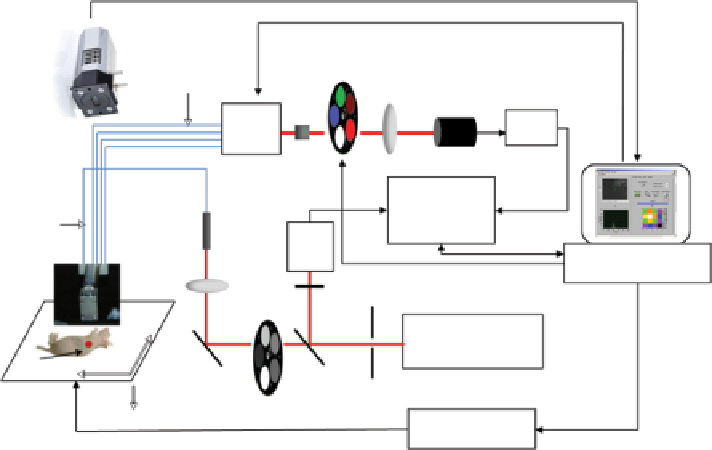Biomedical Engineering Reference
In-Depth Information
Filter wheel
CCD
camera
Emission
fibers
Fiber coup
with lens
Lens
PMT
Optical
switch
Pre-amp
PHOTONCOUNTER
Fiber coupler
SYNC CFD
(TCSPC)
Excitation
fiber
Photo
diode
Computer
Lens
Pin hole
Ti: Sapphire laser
Pulse width: 100 fs
Repetition: 80 MHz
Mirror
Beam
splitter
ROI
ND filter wheel
Scanner controller
FIgure 9.10
Schematic of a time-resolved small animal imaging system. (With permis-
sion from ref. [42]. © Society of Molecular Imaging.)
time for each pixel can be selected based on the maximum intensity of the detected
fluorescence signal and the saturation point of the PMT. The reflected fluorescence
signal is filtered by a high-pass emission filter at maximum emission wavelength of
fluorophore and is collected by a PMT. Detected photons are counted by a TCSPC.
System initialization, data acquisition, and scanning are controlled by the labview
software.
9.4.3
Fd
The performance of FD systems can be linked to that of the TD systems via the
Fourier transform [43]. In the FD technique, the excitation light intensity is sinusoi-
dally modulated at hundreds of megahertz (MHz). Passing modulated light through
tissue changes the amplitude and phase of the fluorescence signal. FD systems can
be used to reconstruct both fluorescence intensity and lifetime.
Figure 9.11 shows the schematic of a FD fluorescence imaging system. The exci-
tation source is a frequency-modulated laser diode at 100.02 MHz frequency. After
being captured by optical fibers, the emitted fluorescence signal, filtered by an
emission filter, is collected by a PMT, and its frequency is downconverted by a mixer
and a local oscillator at 100 MHz frequency. The output signal of mixer is filtered by
a band-pass filter with 20 kHz center frequency to extract the amplitude and phase of
the fluorescence signal and remove the DC and high-frequency components. A sec-
ond mixer extracts the phase difference between source and detector oscillators and
generates a 20 kHz SYNC signal as a reference. System initialization and data acqui-
sition are controlled by the labview software.

Search WWH ::

Custom Search